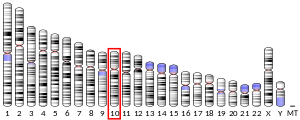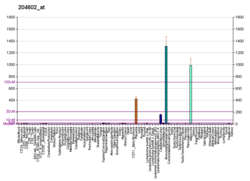DKK1
Dickkopf-related protein 1 is a protein that in humans is encoded by the DKK1 gene.[5]
Function
This gene encodes a protein that is a member of the dickkopf family. It is a secreted protein with two cysteine rich regions and is involved in embryonic development through its inhibition of the Wnt signaling pathway. Dickkopf WNT signaling pathway inhibitor 1 (Dkk1) is a protein-coding gene that acts from the anterior visceral endoderm.[6][7] The dickkopf protein encoded by DKK1 is an antagonist of the Wnt/β-catenin signalling pathway that acts by isolating the LRP6 co-receptor so that it cannot aid in activating the WNT signaling pathway.[8] DKK1 was also demonstrated to antagonize the Wnt/β-catenin pathway via a reduction in β-catenin and an increase in OCT4 expression.[9] This inhibition plays a key role in heart, head and forelimb development during anterior morphogenesis of the embryo.[5][10]
Interactions
DKK1 has been shown to interact with LRP6[11] and is a high affinity ligand of Kremen proteins.[12]
Clinical significance
Elevated levels of DKK1 in bone marrow, plasma and peripheral blood is associated with the presence of osteolytic bone lesions in patients with multiple myeloma.[5] Due to the role of DKK1 in inflammation induced bone loss DKK1 is under investigation as target for therapeutic strategies in medicine and dentistry.[13][14][15]
Animal studies
Scientists have created a DKK1 knockout model in mice that revealed the effects of this gene. All mice that were homozygous for the DKK1 knockout were dead at birth due to defects in the cranium and structures formed by the neural crest, such as failed development of eyes, olfactory placodes, frontonasal mass and mandibular processes, as well as incomplete development of the forebrain and midbrain and fusion of the digits of the forelimb.[7] This evidence supports the idea that inhibition of the Wnt signaling pathway by DKK1 is crucial to proper cranial development.
In vitro studies
DKK1 is one of the most upregulated genes in androgen-potentiated balding, with DKK-1 messenger RNA upregulated a few hours after DHT treatment of hair follicles at the dermal papilla in vitro. Neutralizing antibody against DKK-1 reversed DHT effects on outer root sheath keratinocytes.[16] DKK-1 expression is attenuated by L-threonate in vitro, with the latter a metabolite of ascorbate.[17]
DKK1 and Alzheimer's
Alzheimer's disease occurs due to the overproduction of β-amyloid peptide (βAP) that will cluster together to form plaques between neurons in the brain and disrupt cell function. In addition, there is an accumulation of neurofibrillary tangles of hyperphosphorylated tau inside the neuron.[18] The Wnt signaling pathway is crucial for brain development processes, which include neuron proliferation and differentiation as well as neuroblast migration and axon guidance.[19] Downregulation of this signaling has been shown in Alzheimer’s patients as a result of high levels of DKK1.[19] Because of the hyperphosphorylation induced by DKK1, tau cannot interact with neuronal microtubules consequently compromising axonal transport resulting in synaptic loss and neuronal apoptosis.[18] Because of its antagonistic effects on the Wnt signaling pathway, it is believed that DKK1 is a common marker for neuronal death in neurodegenerative diseases like Alzheimer’s.[19]
References
- GRCh38: Ensembl release 89: ENSG00000107984 - Ensembl, May 2017
- GRCm38: Ensembl release 89: ENSMUSG00000024868 - Ensembl, May 2017
- "Human PubMed Reference:". National Center for Biotechnology Information, U.S. National Library of Medicine.
- "Mouse PubMed Reference:". National Center for Biotechnology Information, U.S. National Library of Medicine.
- "Entrez Gene: DKK1 dickkopf homolog 1 (Xenopus laevis)".
- Schneider VA, Mercola M (1999). "Spatially distinct head and heart inducers within the Xenopus organizer region". Curr Biol. 9 (15): 800–809. doi:10.1016/s0960-9822(99)80363-7. PMID 10469564.
- Mukhopadhyay M, Shtrom S, Rodriguez-Esteban C, Chen L, Tsukui T, Gomer L, Dorward DW, Glinka A, Grinberg A, Huang SP, Niehrs C, Izpisúa Belmonte JC, Westphal H (September 2001). "Dickkopf1 is required for embryonic head induction and limb morphogenesis in the mouse". Developmental Cell. 1 (3): 423–34. doi:10.1016/s1534-5807(01)00041-7. PMID 11702953.
- Lewis SL, Khoo PL, De Young RA, Steiner K, Wilcock C, Mukhopadhyay M, Westphal H, Jamieson RV, Robb L, Tam PP (May 2008). "Dkk1 and Wnt3 interact to control head morphogenesis in the mouse". Development. 135 (10): 1791–801. doi:10.1242/dev.018853. PMID 18403408.
- Ou L, Fang L, Tang H, Qiao H, Zhang X, Wang Z (January 2016). "Dickkopf Wnt signaling pathway inhibitor 1 regulates the differentiation of mouse embryonic stem cells in vitro and in vivo". Molecular Medicine Reports. 13 (1): 720–30. doi:10.3892/mmr.2015.4586. PMC 4686056. PMID 26648540.
- Schneider VA, Mercola M (February 2001). "Wnt antagonism initiates cardiogenesis in Xenopus laevis". Genes & Development. 15 (3): 304–15. doi:10.1101/gad.855601. PMC 312618. PMID 11159911.
- Semënov MV, Tamai K, Brott BK, Kühl M, Sokol S, He X (June 2001). "Head inducer Dickkopf-1 is a ligand for Wnt coreceptor LRP6". Current Biology. 11 (12): 951–61. doi:10.1016/S0960-9822(01)00290-1. PMID 11448771.
- Nakamura T, Nakamura T, Matsumoto K (April 2008). "The functions and possible significance of Kremen as the gatekeeper of Wnt signalling in development and pathology". Journal of Cellular and Molecular Medicine. 12 (2): 391–408. doi:10.1111/j.1582-4934.2007.00201.x. PMC 3822531. PMID 18088386.
- Samiei, Mohammad; Janjić, Klara; Cvikl, Barbara; Moritz, Andreas; Agis, Hermann (2019-01-30). "The role of sclerostin and dickkopf-1 in oral tissues – A review from the perspective of the dental disciplines". F1000Research. 8: 128. doi:10.12688/f1000research.17801.1. ISSN 2046-1402. PMC 6468704. PMID 31031968.
- Ke, Hua Zhu; Richards, William G.; Li, Xiaodong; Ominsky, Michael S. (October 2012). "Sclerostin and Dickkopf-1 as Therapeutic Targets in Bone Diseases". Endocrine Reviews. 33 (5): 747–783. doi:10.1210/er.2011-1060. ISSN 0163-769X. PMID 22723594.
- McCarthy, Helen S; Marshall, Michael J (February 2010). "Dickkopf-1 as a potential therapeutic target in Paget's disease of bone". Expert Opinion on Therapeutic Targets. 14 (2): 221–230. doi:10.1517/14728220903525720. ISSN 1472-8222. PMID 20055719.
- Kwack MH, Sung YK, Chung EJ, Im SU, Ahn JS, Kim MK, Kim JC (February 2008). "Dihydrotestosterone-inducible dickkopf 1 from balding dermal papilla cells causes apoptosis in follicular keratinocytes". The Journal of Investigative Dermatology. 128 (2): 262–9. doi:10.1038/sj.jid.5700999. PMID 17657240.
- Kwack MH, Ahn JS, Kim MK, Kim JC, Sung YK (October 2010). "Preventable effect of L-threonate, an ascorbate metabolite, on androgen-driven balding via repression of dihydrotestosterone-induced dickkopf-1 expression in human hair dermal papilla cells". BMB Reports. 43 (10): 688–92. doi:10.5483/BMBRep.2010.43.10.688. PMID 21034532.
- Boonen RA, van Tijn P, Zivkovic D (April 2009). "Wnt signaling in Alzheimer's disease: up or down, that is the question". Ageing Research Reviews. 8 (2): 71–82. doi:10.1016/j.arr.2008.11.003. PMID 19101658.
- Huang Y, Liu L, Liu A (September 2018). "Dickkopf-1: Current knowledge and related diseases". Life Sciences. 209: 249–254. doi:10.1016/j.lfs.2018.08.019. PMID 30102902.
Further reading
- Fedi P, Bafico A, Nieto Soria A, Burgess WH, Miki T, Bottaro DP, Kraus MH, Aaronson SA (July 1999). "Isolation and biochemical characterization of the human Dkk-1 homologue, a novel inhibitor of mammalian Wnt signaling" (PDF). The Journal of Biological Chemistry. 274 (27): 19465–72. doi:10.1074/jbc.274.27.19465. PMID 10383463.
- Krupnik VE, Sharp JD, Jiang C, Robison K, Chickering TW, Amaravadi L, Brown DE, Guyot D, Mays G, Leiby K, Chang B, Duong T, Goodearl AD, Gearing DP, Sokol SY, McCarthy SA (October 1999). "Functional and structural diversity of the human Dickkopf gene family". Gene. 238 (2): 301–13. doi:10.1016/S0378-1119(99)00365-0. PMID 10570958.
- Roessler E, Du Y, Glinka A, Dutra A, Niehrs C, Muenke M (2000). "The genomic structure, chromosome location, and analysis of the human DKK1 head inducer gene as a candidate for holoprosencephaly". Cytogenetics and Cell Genetics. 89 (3–4): 220–4. doi:10.1159/000015618. PMID 10965128.
- Mao B, Wu W, Li Y, Hoppe D, Stannek P, Glinka A, Niehrs C (May 2001). "LDL-receptor-related protein 6 is a receptor for Dickkopf proteins". Nature. 411 (6835): 321–5. doi:10.1038/35077108. PMID 11357136.
- Semënov MV, Tamai K, Brott BK, Kühl M, Sokol S, He X (June 2001). "Head inducer Dickkopf-1 is a ligand for Wnt coreceptor LRP6". Current Biology. 11 (12): 951–61. doi:10.1016/S0960-9822(01)00290-1. PMID 11448771.
- Zorn AM (August 2001). "Wnt signalling: antagonistic Dickkopfs". Current Biology. 11 (15): R592-5. doi:10.1016/S0960-9822(01)00360-8. PMID 11516963.
- Shou J, Ali-Osman F, Multani AS, Pathak S, Fedi P, Srivenugopal KS (January 2002). "Human Dkk-1, a gene encoding a Wnt antagonist, responds to DNA damage and its overexpression sensitizes brain tumor cells to apoptosis following alkylation damage of DNA". Oncogene. 21 (6): 878–89. doi:10.1038/sj.onc.1205138. PMID 11840333.
- Mao B, Wu W, Davidson G, Marhold J, Li M, Mechler BM, Delius H, Hoppe D, Stannek P, Walter C, Glinka A, Niehrs C (June 2002). "Kremen proteins are Dickkopf receptors that regulate Wnt/beta-catenin signalling". Nature. 417 (6889): 664–7. doi:10.1038/nature756. PMID 12050670.
- Aguilera O, Fraga MF, Ballestar E, Paz MF, Herranz M, Espada J, García JM, Muñoz A, Esteller M, González-Sancho JM (July 2006). "Epigenetic inactivation of the Wnt antagonist DICKKOPF-1 (DKK-1) gene in human colorectal cancer". Oncogene. 25 (29): 4116–21. doi:10.1038/sj.onc.1209439. PMID 16491118.
- Brott BK, Sokol SY (September 2002). "Regulation of Wnt/LRP signaling by distinct domains of Dickkopf proteins". Molecular and Cellular Biology. 22 (17): 6100–10. doi:10.1128/MCB.22.17.6100-6110.2002. PMC 133995. PMID 12167704.
- Gregory CA, Singh H, Perry AS, Prockop DJ (July 2003). "The Wnt signaling inhibitor dickkopf-1 is required for reentry into the cell cycle of human adult stem cells from bone marrow". The Journal of Biological Chemistry. 278 (30): 28067–78. doi:10.1074/jbc.M300373200. PMID 12740383.
- Tian E, Zhan F, Walker R, Rasmussen E, Ma Y, Barlogie B, Shaughnessy JD (December 2003). "The role of the Wnt-signaling antagonist DKK1 in the development of osteolytic lesions in multiple myeloma". The New England Journal of Medicine. 349 (26): 2483–94. doi:10.1056/NEJMoa030847. PMID 14695408.
- Yamaguchi Y, Itami S, Watabe H, Yasumoto K, Abdel-Malek ZA, Kubo T, Rouzaud F, Tanemura A, Yoshikawa K, Hearing VJ (April 2004). "Mesenchymal-epithelial interactions in the skin: increased expression of dickkopf1 by palmoplantar fibroblasts inhibits melanocyte growth and differentiation". The Journal of Cell Biology. 165 (2): 275–85. doi:10.1083/jcb.200311122. PMC 2172049. PMID 15117970.
- Caricasole A, Copani A, Caraci F, Aronica E, Rozemuller AJ, Caruso A, Storto M, Gaviraghi G, Terstappen GC, Nicoletti F (June 2004). "Induction of Dickkopf-1, a negative modulator of the Wnt pathway, is associated with neuronal degeneration in Alzheimer's brain". The Journal of Neuroscience. 24 (26): 6021–7. doi:10.1523/JNEUROSCI.1381-04.2004. PMID 15229249.
- Colland F, Jacq X, Trouplin V, Mougin C, Groizeleau C, Hamburger A, Meil A, Wojcik J, Legrain P, Gauthier JM (July 2004). "Functional proteomics mapping of a human signaling pathway". Genome Research. 14 (7): 1324–32. doi:10.1101/gr.2334104. PMC 442148. PMID 15231748.
- Zhang Z, Henzel WJ (October 2004). "Signal peptide prediction based on analysis of experimentally verified cleavage sites". Protein Science. 13 (10): 2819–24. doi:10.1110/ps.04682504. PMC 2286551. PMID 15340161.
- Niida A, Hiroko T, Kasai M, Furukawa Y, Nakamura Y, Suzuki Y, Sugano S, Akiyama T (November 2004). "DKK1, a negative regulator of Wnt signaling, is a target of the beta-catenin/TCF pathway". Oncogene. 23 (52): 8520–6. doi:10.1038/sj.onc.1207892. PMID 15378020.
- Lee AY, He B, You L, Xu Z, Mazieres J, Reguart N, Mikami I, Batra S, Jablons DM (October 2004). "Dickkopf-1 antagonizes Wnt signaling independent of beta-catenin in human mesothelioma". Biochemical and Biophysical Research Communications. 323 (4): 1246–50. doi:10.1016/j.bbrc.2004.09.001. PMID 15451431.




